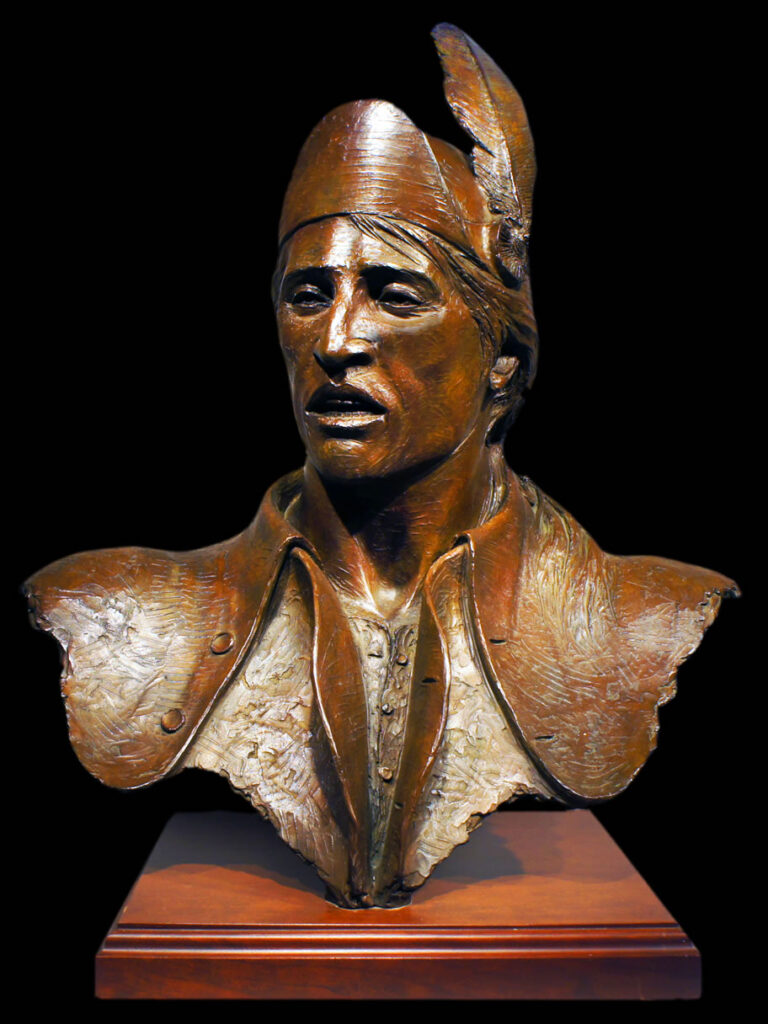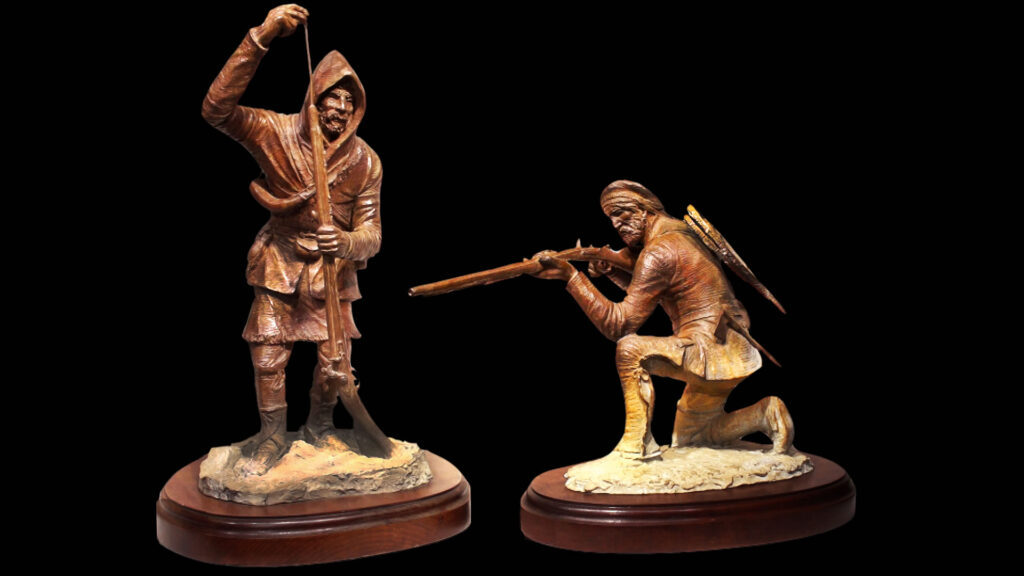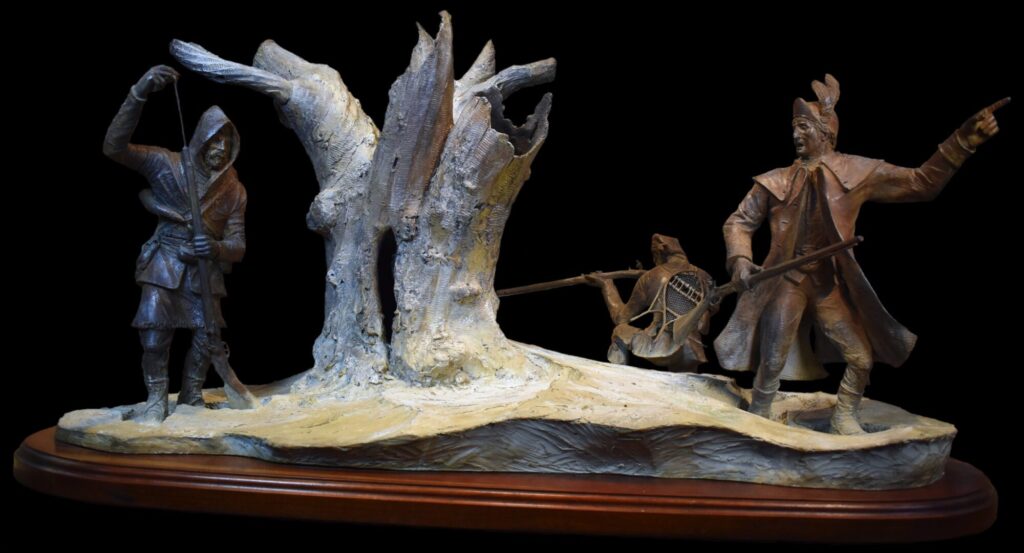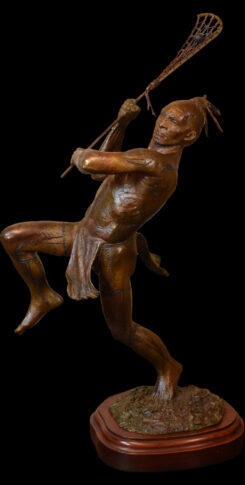Bronze edition: 9 | Height: 27″
“The great and fundamental principle of [the Indians] policy is that every man is naturally free and independent, that no one on earth has the right to deprive him of his freedom and independence and that nothing can be a compensation for the loss of it. …Among all the nations and tribes in this vast extent of country, those called the five nations (Iroquois) stand distinguished and deserving of the first notice. They are dreaded and revered by all others for their superior understanding, activity and valor in war, in which constant practice renders them expert.”
Maj. Robert Rogers
“A concise Account of North America,” 1765
Robert Rogers was born in Dunbarton, NH and grew up in the New Hampshire frontier. As a young man he received valuable field knowledge regarding forest warfare during “King Georges War” (1744-48) from veterans of Captain Lovewell’s Indian fighters who had successfully engaged the Pigwacket Abenaki war chief Paugus in May 1725.
In the next and final conflict between France and England, the “French and Indian War” (1754-60), the colonial ranging companies were equipped to serve as scouts tracking enemy movements and quick reaction strike forces against Canadian partisans and their Indian allies. Rogers’ Rangers were the most famous of the colonial ranging companies.
Like most early ranger recruits, Rogers was of Scots-Irish descent, “all lustie, stout men 6′ high,” exceptionally tough as well as brave, “men with constitutions like lions.” Roger himself was 6′ tall and described as “a man of uncommon strength.” As with most provincial military units, the Rangers were egalitarian and exhibited none of the social hierarchy that characterized the British regular army. Rogers was well liked and respected by his men. His good-natured camaraderie was joined to a generous nature and characteristic coolness under fire. General Abercrombie recognized the value of Rogers when he remarked: “without him these four companies would be good for nothing.” Knowing well the abilities as well as the temperament of his men, Rogers exerted a cautious hand over them. He thus not only kept a potentially “riotous sort of people” (in the words of Colonel Haviland) under control, but was a born leader who had the gift of inspiring his men to accomplish Herculean tasks and to persevere to the limits of human endurance.
Since ranger operations were largely unknown to the regular British army, Lord Loudon instructed Rogers in 1756 to draft a manual or “rules of plan of discipline for these gentleman officers who wanted to learn ranging methods of marching, retreating, ambushing and fighting etc.” Most of the rules were derived from old Indian tactics.
The ranger example not only led to practical adjustments in the dress, arms, accoutrements and tactics of the regular army but also inspired the 1st regiment of light infantry. Rogers’ contribution to this unique military art was so significant that his “29 Ranging Rules” are still posted at Ranger battalion headquarters at Ft. Benning, GA. Many of the Rangers under Rogers’ command later became Colonels and Generals in the American Revolutionary Army, among them Gen. John Stark and Gen. Israel Putnam.
Robert Rogers meteoric rise to prominence in his late 20’s culminated in his being lionized in London with the publication of two books in 1765: “The Journals” and a “Concise Account of North America” as well as writing a play ” Ponteach” (Pontiac) performed in London about the same time. The latter reflected his meetings with and observations of the great Ottawa leader at the time Rogers was given the important but difficult task of taking control of all of the French outposts in the Great Lakes after the fall of Montreal in 1760.
From this point however his life, it seams, spiraled downward beset by financial difficulties and the effects of alcohol. He briefly reappeared on history’s stage during the American Revolution when he formed the Queen’s Rangers after his offer to serve the American cause was declined. Made up of Tories with little expertise in woodcraft or warfare, the Queen’s Rangers saw limited action and were but a pale shadow of the Rogers Rangers of the 1750’s. He died in a London debtors prison penniless and physically broken at the age of 64.
Excerpts from
“The American Colonial Rangers”
by Gary Zaboly, 2004
The Legend of Rogers Rock
At the close of “the battle on snowshoes” in March, 1758 (Rogers’ only defeat in 5 years during the French and Indian War), legend has it that Rogers made his escape by climbing to the summit of Bald Mountain. Breathlessly he looked down at the frozen surface of Lake George nearly 1000′ below. The daredevil in him seemed to possess him for a moment as he contemplated sliding down the rock face on his snowshoes. With the sound of the Indians shouting exhaltantly in the distance as they picked up his trail, common sense however got the better of him but he conceived of the idea of conveying the impression of this feat to his pursuers. He threw his pack down, leaving a trail in the snow before it plummeted over the edge. He loosened the thongs on his snowshoes, turned about face, and laced them on backwards. He then carefully backtracked, swung himself by a branch into a defile and made his way down to the lake. Hardly had he reached it than the Indians reached the summit and in the moonlight spotted Rogers making his way up the lake. They were awe-struck at the apparent feat of sliding down on his snowshoes, were convinced he was watched over by some manitou and gave up the chase. (To this day locals insist that he did slide down the rock face and Bald Mt. has been known as “Rogers Rock” ever since.)
“The History of Rogers Rangers,” Vol I by B. Loescher, 1946







